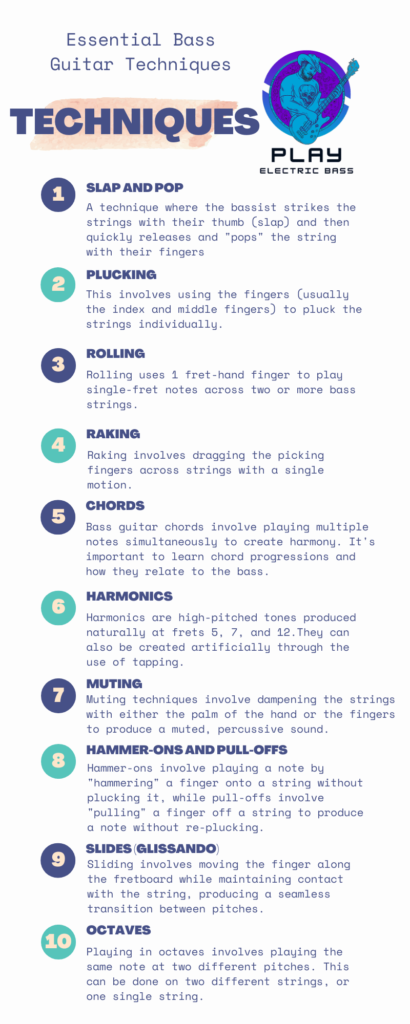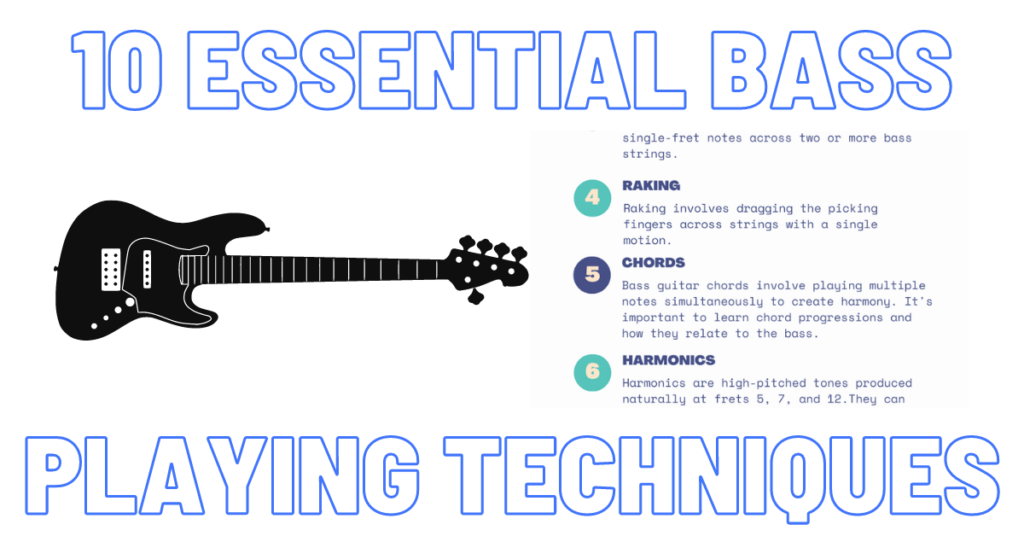Discover the top bass playing techniques that will take your skills to the next level. From fingerstyle to slap bass, this article explores the best techniques used by professional bassists. Improve your groove, speed, and versatility with these expert tips and tricks.
You can’t play bass guitar, or any other instrument, without understanding technique.
That’s why I’ve put together this list of 10 essential bass playing techniques.
Learning them will make playing the bass a lot more fun for you, and they’ll help you become a “complete” bassist, and a better musician.

Slap and pop
You didn’t expect a list of best bass playing techniques without slapping and popping, right?
Slapping is a sound that’s relatively unique to the bass guitar. It’s used to create a funky, percussive, staccato sound used in many genres, especially funk, jazz, and rock.
And naturally, I have to send you to Scott’s Bass Lessons to learn how to slap and pop, because they always deliver high-quality lessons!
Plucking technique
Plucking is the technique most bassists use to play the strings, rather than using a bass guitar pick.
You’ll generally pluck by alternating your index and middle fingers while resting your thumb on the pickup. This is the most common type of bass plucking, referred to as alternate plucking.
Some bassists also incorporate their ring finger for plucking, but this is a more advanced, complex form of plucking.
Rolling
A bass guitar roll is a fret-hand technique where you use a single finger to play single-fret notes across two or more bass strings. It’s often combined with raking.
This allows for some fast, really cool bass licks utilizing 4th, 5th, and b7 intervals.
Raking
Raking is a simple picking-hand technique used to play multiple strings with a single sweeping motion.
This enables you to play quickly, and makes for a very clean sounding execution of notes.
It also looks awesome, which is great if you’re a performer!
Chords
Bass is mostly known for playing single-note lines, but learning harmony and playing chords will make you sound like a boss, and help you to understand other musicians.
Since the bass frets are so large, it’s best to start off learning diads (2-note chords, also called “harmonic intervals”) and triads (3-note chords).
From here you can start to move the chords around and play chord progressions such as a I-IV-V, or a ii-V-I.
Learning bass chords and harmony will open up the fretboard and make your bass-playing experience even better!
Harmonics
Do you know that crazy sound the bass guitar makes at the beginning of “Birdland” by Weather Report? That’s harmonics, being played by the mighty Jaco Pastorius. You can learn more about harmonics with this harmonics guide from Yamaha.
Harmonics give a high-pitched “bell-like” tone, and occur naturally at frets 5, 7, and 12. Play them by lightly hovering above the fret inlay, gently resting your finger on the string, then plucking.
Bass muting
Muting assists in the elimination of notes ringing out. It’s also a key technique for controlling dynamics.
The most popular form of bass guitar muting is arguably palm muting. This is done by resting the palm of your picking hand lightly on the strings where they meet the bridge, then picking the palm muted string(s).
You can also use your left hand to mute. This is typically done for resting and playing bass chords.
Hammer-ons and pull-offs (legato)
Bass hammer-ons involve using your fretting hand to literally “hammer” a finger onto a higher fret, producing a note without picking the string again.
For example, if you hammered on from fret 3 to fret 5, you’d pick fret 3 with your index finger, then use your pinky to hammer-on to fret 5. This results in legato, a continuous sound caused by moving from one note to the next without any pause in between them.
Pull-offs are the reverse. This is where you’ll pull-off from a higher note to a lower note using a fret-hand plucking motion.
For example, if you have your pinky finger on fret 5 and your index finger on fret 3, you could pick fret 5 and pull-off to fret 3 using the strength of your pinky. The pinky finger literally pulls of the string downward to create the pull-off motion, removing any need to use the picking hand.
Pull-offs are technically not legato, because the notes don’t blend together.
Slides (Glissando)
Glissando, informally known as sliding, is moving from one note to another (on a single string) while continuing to keep pressure on the string.
This means you must not lift away from the fretboard when you’re sliding! The slide ends when you’ve landed on your target note.
Octaves
Octaves are one of the easiest ways to spice up your standard bass riffs and bass lines.
Playing octaves is simply playing a note and its corresponding octave. An octave is the same note that you’re currently playing, but in a higher or lower pitch.
You can play an octave on 2 different strings, or you can use a combination of an open string and it’s corresponding fretted note. An example of the open string and it’s corresponding note is:
- Play the open A string
- Play the octave, which is at the 12 fret of the A string
You’ll often hear octaves used to reinforce the root note of a chord or melody, improving the musical foundation.
One of my favorite uses of bass octaves is in the song Turn Me Loose by Loverboy.
Bonus: Picking
I didn’t want to include picking as one of the top 10 bass-playing techniques because I don’t think it’s essential to learn. Despite this, it’s still a useful bass technique.
Picking uses a flat pick, also called a “plectrum”, to play the bass strings. This creates a distinct sound compared to plucking.
It’s particularly well-suited for genres requiring a more aggressive tone, like punk, metal, and some forms of rock.
Learning to control the angle and attack of the pick against the strings enables you to modulate your tone and achieve a variety of timbres.
This technique can also add an element of percussiveness to your playing, making it a staple in high-energy basslines.
Bass playing techniques summary
Here’s a recap and summary of the 10 essential bass playing techniques:
- Slap and Pop: A technique where the bassist strikes the strings with their thumb (slap) and then quickly releases and “pops” the string with their fingers, creating a percussive and rhythmic sound.
- Plucking: Also known as fingerpicking, this involves using the fingers (usually the index and middle fingers) to pluck the strings individually, creating distinct and controlled sounds.
- Rolling: Rolling uses 1 fret-hand finger to play single-fret notes across two or more bass strings.
- Raking: Raking involves dragging the picking fingers across strings with a single motion. This technique is often used to emphasize rhythm or play fast bass lines.
- Chords: Bass guitar chords involve playing multiple notes simultaneously to create harmony. It’s important to learn chord progressions and how they relate to the bass guitar.
- Harmonics: Harmonics are high-pitched tones produced naturally at frets 5, 7, and 12. They can also be created artificially through the use of tapping.
- Muting: Muting techniques involve dampening the strings with either the palm of the hand or the fingers to produce a muted, percussive sound. This adds to the rhythmic texture of the playing.
- Hammer-ons and Pull-offs: Hammer-ons involve playing a note by “hammering” a finger onto a string without plucking it, while pull-offs involve “pulling” a finger off a string to produce a note without re-plucking. These techniques enable smoother and more fluid playing.
- Slides (Glissando): Sliding involves moving the finger along the fretboard while maintaining contact with the string, producing a seamless transition between pitches. This can create a smooth gliding effect.
- Octaves: Playing in octaves involves playing the same note at two different pitches. This can be done on two different strings, or one single string.
Can’t play a bass technique right now? Don’t worry! It just takes time.
Practice consistently, and incorporate them into your playing whenever you want. Focus on the techniques that stand out most to you, or compliment you in a band setting.
Pay attention to both your left-hand and right-hand positioning, because they’re both invaluable and have to work together when executing a technique.
Lastly, I call these the essential bass playing techniques because all of them have contributed to the bass guitar’s versatility and sounds throughout musical history.
Looking for what to learn next?
Learning your bass string notes will make it much easier to understand bass guitar as a whole, making it easier to implement bass techniques.
If you’re intimidated by scales, check out this pentatonic scale bass lesson. The pentatonic scale is very easy to learn and you can start using it within 1 minute of looking at the lesson!
Rock on, and keep practicing!

